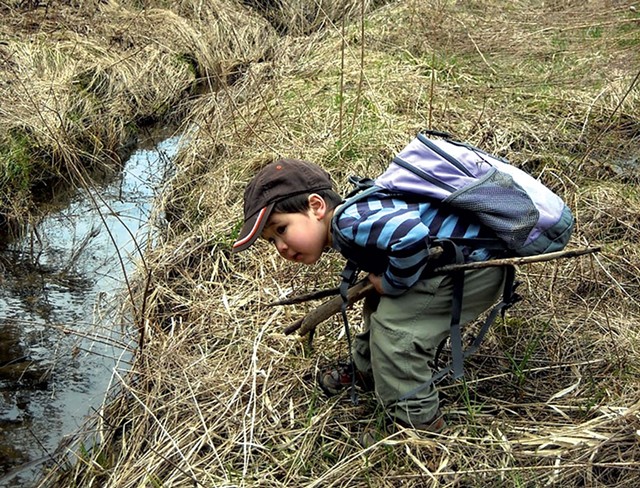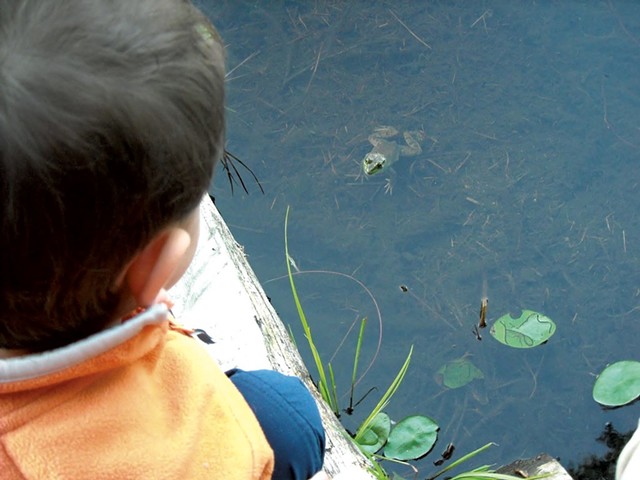Published April 30, 2019 at 10:00 a.m.
May is a great month to look for frogs. For starters, they're making a lot of noise at this time of year. That's because now is when many species are trekking through the woods to the nearest body of water to mate and lay eggs. The males are calling out to females: "Here I am! Pick me!"
To go on a frog-hunting expedition, simply follow the sound. Even within the Burlington city limits, you'll find multiple species in wet places, such as the retention pond near Centennial Field, the boardwalk near Ethan Allen Homestead, and maybe even your own backyard.
Another technique, recommended by naturalist Erin Talmage, who has contributed more than 100 observations to the Vermont Reptile and Amphibian Atlas — which has gathered extensive data about our state's reptiles and amphibians — is to keep an eye out for cattails. Since cattails grow in wet areas, there will likely be frogs nearby.
You can also use the free iNaturalist app (or go to inaturalist.org) to find frogs near you. It allows you to search for locations where different species of plants, animals or fungi have been reported. If you post a photo of something you've found, an expert on the app will help you identify it. You don't even need to become a member unless you want to leave comments and suggest identifications.
Once you find frogs, what's next? I like to just sit and listen. The rest of my family enjoys mucking about and looking for more calling frogs, eggs and tadpoles. Consider boots or water shoes if you choose this option.
You'll usually find frog eggs in large gelatinous masses. I might jiggle the stick they are attached to, but I never take them out of the water. It's OK to pick up frogs and tadpoles with wet hands, though, as long as you're not wearing lotion or sunscreen. Frogs do much of their breathing through their skin, and residues on your skin can harm them. Also, don't bring home the critters you find. They do best in their native habitat.
Go back over the next few weeks or months to watch the tadpoles hatch and grow. You might notice that the numbers of eggs and tadpoles dwindle as weeks pass. To encourage your budding scientist's observation skills, sit and watch for a predator — perhaps a fish, bird or even an insect — to eat an egg or tadpole. It might even provide fodder for a discussion about life eating life.
Since the amphibious ruckus is all about mating — which frogs do by a method called external fertilization — it's also a good opportunity to talk about sperm and eggs. In the frogs' case, the females discharge eggs, then males spray sperm on them.
To figure out what species are in your pond, listen closely to their calls. My favorite online recordings of frog calls are on musicofnature.com, the website of naturalist and author Lang Elliot. Every frog makes a distinct call, and they are surprisingly easy and satisfying to learn.
Call of the Frogs
These are the most common frogs found in Vermont, listed in the approximate chronological order in which their calls peak. For more information, visit the Vermont Reptile and Amphibian Atlas at vtherpatlas.org.
- Wood frogs are the first frogs you hear calling, peaking in mid-April. To my ear, they make a chuckling sound; guidebooks often describe it as a duck-like quacking. They are brown or reddish with darker "backpack straps" along the side of each shoulder. They are usually found in vernal pools, low-lying spots in the forest that fill with snowmelt for a few months in spring and summer and then dry out, making them safe from egg- and tadpole-eating fish.
- Many people compare spring peepers' vocalizations to jingling sleigh bells from a distance, but up close, they are loud and piercing. They can start as early as March and continue through July, peaking in early May. They are smaller than Vermont's other frogs — around 1-1.5 inches — brown, and they often have an "X" on their backs. They are not too fussy about the bodies of water they choose to lay their eggs. Even a ditch can suffice.
- The American toad's call is a high-pitched trill that lasts up to 30 seconds. It calls from April through July, peaking in early May. They have dry, warty skin and are the most common amphibian in Vermont.
- The gray treefrog repeats its short trill every few seconds. They often call from trees (where they feed) on warm, humid nights from April to July, peaking in early June. They breed in slow or still water bodies that are heavily vegetated, and range in color from green to gray. Adults have bumpy, irregular patterns on their backs that look like lichen.
- The green frog (pictured) call sounds like a plucked banjo string: "GUNK gunk gunk." It can be heard from April through July, peaking at the beginning of July. Their appearance is quite variable, ranging from mottled green to brown, with stripes — often broken — on their legs.
- In my family we call the American bullfrog the NASCAR frog, because its call sounds like cars racing around a track. I hear a deep "rum, rum," though many guidebooks describe it as "jug-o-rum." They call from May to August, peaking in early July. They are our largest frog; their bodies (not including legs!) can be up to 7 inches long. They range from mottled green to brown, have stripey legs, and are found in or near large bodies of water with a marshy shoreline nearby.
Heather Fitzgerald teaches field ecology and environmental science at the Community College of Vermont and the University of Vermont.
This article was originally published in Seven Days' monthly parenting magazine, Kids VT.
More By This Author
Speaking of...
-

Meg Madden Champions the Hidden Roles and Art of Mushrooms
Nov 2, 2022 -

Video: Essex Art League’s Plein Air Painters Visit Mount Philo
Jul 28, 2022 -

Mom Takes Notes, July 2021
Jun 29, 2021 -

Essay: In Appreciation of the 'Outdoor Home'
Jun 15, 2021 -

Video: Tom Locatell Hews Fallen Trees at Gilbrook Nature Area in Winooski
May 20, 2021 - More »
Comments
Comments are closed.
From 2014-2020, Seven Days allowed readers to comment on all stories posted on our website. While we've appreciated the suggestions and insights, right now Seven Days is prioritizing our core mission — producing high-quality, responsible local journalism — over moderating online debates between readers.
To criticize, correct or praise our reporting, please send us a letter to the editor or send us a tip. We’ll check it out and report the results.
Online comments may return when we have better tech tools for managing them. Thanks for reading.

















































